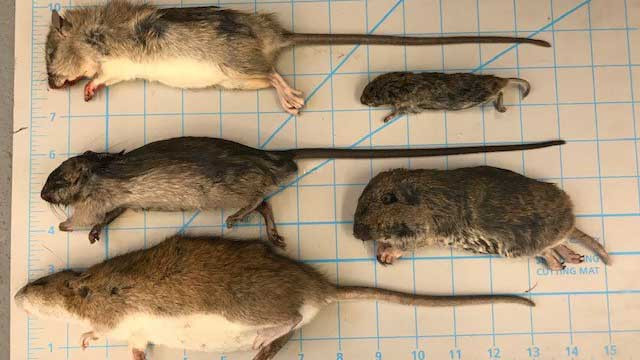Overview
If a rodent is spotted in the daylight crossing a road or highway, it is unlikely to be a rat and probably is a muskrat.
Norway and roof rats can be identified by a number of distinguishing characteristics and clues. However, most ‘rats’ reported in Alberta are in fact other rodents such as muskrats. Before reporting a rat, view the list below, then find out how to identify rats and their signs.
Rodents mistaken for rats
-
 Muskrat
MuskratMuskrats are commonly seen travelling overland and sometimes far distances from water, especially in the fall and spring. Many ‘rats’ reported in Alberta are actually muskrats.
- Colour: brown/black
- Size: body is approximately 45 to 70 cm (18 to 27 in) long
- Other features: large toenails on hind feet and long, scaled, blackish, flattened tail
-
 Deer (or white-footed) mouse
Deer (or white-footed) mouse- Regulated nuisance in Alberta
- Colour: variations of brown
- Size: body is 8 to 10 cm (3 to 4 in) long
- Other features: large, beady eyes and large ears
- See also: Mice and Their Control
-
 House mouse
House mouse- Regulated nuisance in Alberta
- Colour: grayish-brown, with gray or buff belly
- Size: body is 6.5 to 9 cm (2.5 to 3.5 in) long
- Other features: slightly pointed nose, small feet, small, black protruding eyes, large ears
- See also: Mice and Their Control
-
 Northern pocket gopher
Northern pocket gopher- Regulated nuisance in Alberta
- Colour: grey/brown
- Size: body is 15 to 25 cm (6 to 8 in) long
- Other features: distinctive cheek pouches, long incisor teeth, long feet, large claws, short tail
- See also: Control of Pocket Gophers and Ground Squirrels
-
 Meadow vole (field mouse)
Meadow vole (field mouse)- Regulated nuisance in Alberta
- Colour: dark brown to reddish brown
- Size: body approximately 9 to 14 cm (3.5 to 5.5 in) long
- Other features: stocky with short legs and tail; ears partially hidden
- See also: Mice and Their Control
-
 Richardson ground squirrel (gopher)
Richardson ground squirrel (gopher)- Regulated nuisance in Alberta
- Colour: Buffy grey, flecked appearance caused by speckling of dark hairs and black tip on tail
- Size: body is 20 to 24 cm (8 to 9.5 in) long
- Other features: tiny ears, large eyes, bushy tail
- See also: Managing Richardson’s Ground Squirrels, Control of Pocket Gophers and Ground Squirrels
-
 Squirrel
Squirrel- Colour: reddish, rusty brown
- Size: body is approximately 20 cm long
-
 Ord’s kangaroo rat
Ord’s kangaroo rat- Endangered species in Alberta
- Colour: Brownish orange with greyish black on the midline
- Size: Body approximately 10 to 12 cm (4 to 5 in); tail can be 13 to 16 cm (5 to 6 in) long
Image credit: Ord's Kangaroo rat, Alberta by Andy Teucher is licensed under CC BY-NC 2.0.
-
 Bushy tailed wood rat (pack rat)
Bushy tailed wood rat (pack rat)- Regulated nuisance in Alberta
- Colour: silver grey to dark grey to brown
- Size: body is 20 to 25 cm (8 to 10 in), tail length is 10 to 21 cm (4 to 8 in)
- Other features: bushy tail
Rodent comparison
See Rat and Mouse Comparison fact sheet.
For size comparison, see below, top to bottom: mouse, vole, juvenile roof rat, pocket gopher, Norway rat

Report a rat
If you think you saw a rat, see how to identify and report a rat.